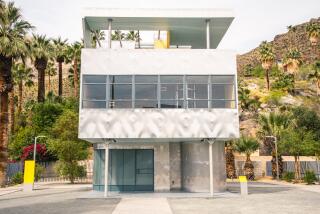On Nov. 16, 1911, a staunch little...
- Share via
On Nov. 16, 1911, a staunch little group of notables hacked a trail through the hillside brush above Highland Park, determined to give the new Southwest Museum a proper ground breaking.
Shovel in hand, Elizabeth B. Fremont, daughter of Gen. John C. Fremont, dutifully broke the ground and presented the Fremont flag to Charles F. Lummis, the museum’s primary founder.
Not too many museums are built on a hill, nor do they usually look like castles with a flag flying from its lone turret, but Lummis was a poetic individual and deeply fascinated by the Spanish and native Indian cultures that had influenced the Southwest.
Explorer, preserver of missions, author, city librarian and one-time city editor of the Los Angeles Times, Lummis was an admirer of the architectural splendor of the castles of Spain and developed his own castle-like concept, which he commissioned architects Sumner Hunt and Silas R. Burns to embellish.
The sum of $22,000 was raised to purchase 17 acres of land where the museum now stands, on Museum Way at the base of Mt. Washington. The building was completed in 1914 at a cost of about $80,000.
Since the hilltop site was quite inaccessible to museum visitors, an additional $50,000 was spent for the construction of a 260-foot tunnel off Museum Drive that was driven horizontally into the rocky hill at street level. The tunnel connected with a 108-foot vertical shaft equipped with an elevator to convey passengers to the structure’s upper levels.
A striking architectural feature is the museum’s winding, seven-story Caracol Tower, modeled after a 92-step “snail staircase” of a cathedral in Mexico.
Currently, under the administration of Jerome R. Selmer, the museum remains one of the richest repositories for the history of the Southwest, with more than 100,000 items available to students and researchers.
Photographic views, taken more than 50 years apart, attest to very little change to the impressive structure.
More to Read
The biggest entertainment stories
Get our big stories about Hollywood, film, television, music, arts, culture and more right in your inbox as soon as they publish.
You may occasionally receive promotional content from the Los Angeles Times.










